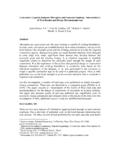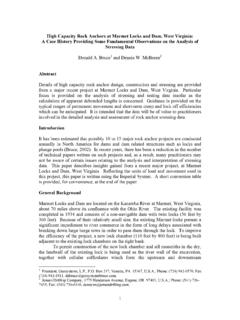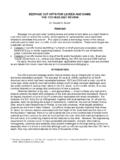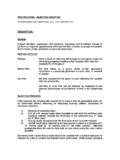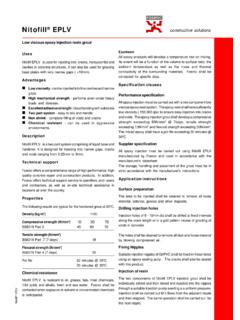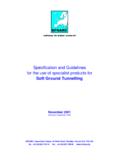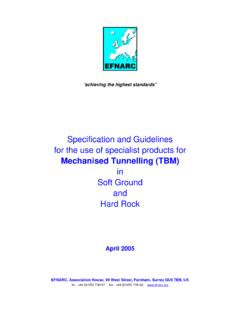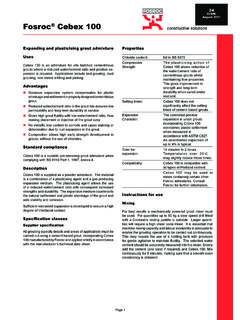Transcription of Contemporary Rock Drilling and Grouting Practices
1 1 Contemporary Rock Drilling and Grouting Practices Dr. Donald A. Bruce, Geosystems, It is generally recognized, both nationally and internationally, that rock Grouting theory and practice in North America has undergone a most positive revolution during the last decade or so. Key elements of this progress have included the development and use of suites of balanced, stable High Mobility Grouts (HMG); increasing use of Low Mobility Grouts (LMG); new overburden and rock Drilling methods; computer monitoring control and analysis; and the use of Apparent Lugeon Theory and Lugeon testing to assure proper stage refusals and low residual permeabilities, respectively. These concepts have been most strongly implemented on major Federal dam remediation projects. Also, certain consultants are using them on smaller, non-Federal projects.
2 However, the author has noted over the past few years a distinctly retrogressive faction in the Grouting industry which, if left unchallenged, will undo much of the advantages gained over the last decade. Examples include a reversion to the use of highly unstable HMG s as engineers confuse thin and high water content. Perhaps more concerning is the re-emergence in certain circles of the thirty-year-old GIN Method ( Grouting Intensity Number). This method was devised with the laudable goal of trying to assure a certain basic standard of care in Grouting projects in countries of a lesser degree of resource and sophistication. In this paper, the author urges against the regression in Grouting practice, which is in danger of occurring due to a relapse into old, unsatisfactory habits, and a rediscovery of outdated and inappropriate methodologies.
3 The Grouting industry today is ranked amongst the most active and effective in the world, and this level of approbation should be guarded and cultivated, not let slide. Keywords: cement grouts, computer control, cutoffs, permeability testing, rock Drilling , rock Grouting , Introduction Rock Grouting for dam foundations has been carried out in the since at least 1893 when the limestone bedrock of a dam in the New Croton Project, NY, was treated with cement grout (Franklin and Dusseault, 1989). Opinions differ on the method of injections (Glossop, 1961, Littlejohn , 2003), although other reports (Verfel, 1989) strongly suggest that Grouting procedures had made a good start. For the best part of the following hundred years, the intense history of dam Grouting in the is, to some extent, a picture of objectives not fully achieved, innovative procedures and insightful ideas inconsistently implemented, and a number of questionable Practices unthinkingly perpetuated.
4 During the last 15 years, however, in many but not all parts of our practice, there has been a radical change in our concepts and in our approaches to such work. Partly drawing from knowledge made available in the by European specialists, for example at the seminal Grouting conferences hosted in New Orleans in 1982, 1992 and 2003, and partly by the very challenging problems posed by the need to construct remedial grout curtains in our own dams, especially on karst, there has been a technological revolution in dam Grouting Practices in the This revolution has greatly benefited the owners of these dams, and dams themselves, and by association the Grouting profession at large. However, the proven advantages and successes of this uniquely tailored advance have not yet everywhere been recognized, and have not always been upheld and consistently defended.
5 We therefore find that in some regions, or in certain organizations or most sadly in certain sections of certain organizations rock Grouting is still being specified in the terms of 50 years ago. Equally, there are increasing numbers of projects being specified and 2 run according to new concepts which, in reality, are new only to the designers and represent a retrogressive step of almost 30 years. In the following sections, the old, the new and the retrogressive concepts of rock fissure Grouting are presented to provide a platform for logically arguing against the old and the retrogressive ways of approaching work of this type. Given the relatively high volume of dam Grouting especially for remedial applications being conducted today, we have now arrived at a particularly important time to have this debate.
6 Historical concepts ( the old ) There is a trove of published information to be found on this subject, including the Proceedings from the New Orleans Grouting Conference in 1982, the Foundations for Dams Conference (1974) and textbooks by Houlsby (1990), and Weaver (1991) in particular. Even more important are the unpublished reports, memoranda and manuals produced on a project-specific basis, or by companies or governmental organizations. These had special gravitas because their authors strongly influenced the next generation of Grouting engineers while they, themselves, were elevated to the position of consultants on other projects in different governances. Bearing in mind the unprecedented level of activity in those years in new dam Grouting , as well as the national puritanism towards low bid contracting, specifications were highly prescriptive and restrictive.
7 Such prescriptions did nothing to stimulate innovation since the contractor was reduced to the status of the cheapest purveyor of labor, equipment and materials, while the goal of the owners inspectors was to ensure that the specifications were enforced to the letter, via hole by hole direction of the Grouting activities. By the way of illustration, in 1974, Polatty was invited to give an overview of Dam Grouting Practices : In preparing this paper, I requested copies of current specifications for foundation Grouting from several Corps of Engineers districts, the TVA and the Bureau of Reclamation. In comparing these current specifications with copies of specifications that I had in my file that are 30 years old, plus my observations and experience, I concluded that we in the United States have not, in general, changed any of our approaches on Grouting .
8 AND THIS IS GOOD (emphasis added). Interestingly, he then went on to list difficulty in having sufficient flexibility in the field to make necessary changes to ensure a good Grouting job as a problem. What a surprise! As a consequence, several important historical paradigms became embedded in our national practice as late as the 1980 s. These include: The Drilling of vertical holes, to a target depth (as opposed to stratigraphic horizon). The only common exception ( , Albritton, 1982) would be the concept of inclining the curtain upstream, so as to physically distance it from the downstream drains. The use of rotary Drilling (often just coring) since in the early days of the 20th century since only such drills could use water flush. Percussion Drilling was then synonymous with the use of air flush, which many (but not all) did recognize as detrimental to fissure cleanliness and amenability to grout.
9 (The age old debate about rotary versus percussion Drilling as being more suitable for grout holes was wrongly focused: it should have been water versus air.) The concept of a one row curtain, except notably under the cores of embankment dams, where even then the shallowest possible excuse was taken to revert to one row. The use of relatively low grout pressures, resulting from the recurrent specification to provide constant pressures which therefore meant the use of progressive cavity pumps ( Moynos ) as opposed to higher pressure piston or ram pumps. 3 The use of thin grouts (with excessive water:cement ratios often well in excess of 10 by weight although typically mixes were measured by volume). Such mixes of course were easy to pump due to their low apparent viscosity, but naturally had extremely high bleed values and horrible pressure filtration resistance.
10 These mixes were allied with a fundamental distrust/unawareness of the benefits of additives (except for calcium chloride in taker situations) although, latterly, the use of bentonite was entertained and ongoing though somewhat misguided experimentation with superplasticizers was conducted in certain quarters. Curtains were grouted until a certain cement refusal was obtained ( , 1 bag per foot) as opposed to a measured residual permeability. This is, however, a charitable view: often the Grouting was discontinued when the budget was expended and, in the aftermath when the underseepage became of alarming quantities, the cry was made that the Grouting didn t work! The general result (Weaver and Bruce, 2007) of these deficiencies was either a) a poor travel of grout in the ground, leading to the Drilling of families of higher order holes at ridiculously close centers ( , 1 foot at Chickamauga Dam, TN), or b) uncontrollable flow of thin grouts into karstic voids or similar major features.

